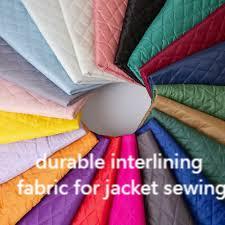Exploring Modern Apparel Solutions with Interlining from interlining-factory

In today’s garment industry, achieving both aesthetic appeal and structural integrity depends heavily on how Interlining is selected and used in various apparel pieces. Whether working with delicate fabrics or crafting tailored outerwear, the right Interlining ensures garments hold their shape, withstand daily wear, and deliver a premium feel to consumers.
Precision in Fabric Construction
Behind every crisp collar or structured waistband lies careful engineering. Fabric engineers consider numerous factors like thickness, softness, and bonding techniques. Even minor differences in the weight or density of support layers can influence how clothing drapes or maintains its silhouette. Attention to detail during product development sets apart high-end garments from mass-market alternatives, ensuring comfort and long-term durability.
Innovative Material Technologies
Advancements in textile technology have transformed the support materials used in fashion. Traditional woven or nonwoven materials are now joined by high-performance blends that can stretch, wick moisture, or remain ultra-lightweight. Manufacturers increasingly integrate sustainable fibers and adhesives that reduce environmental impact. These new materials accommodate trends such as athleisure, which demands flexibility, breathability, and resilience all at once.
Customization for Diverse Design Needs
Designers and manufacturers often require tailored solutions to achieve unique visions. Customizable support layers enable different finishes for everything from sheer blouses to thick winter coats. Variations in stiffness, bonding strength, and elasticity help maintain desired garment shapes while preserving the feel of the exterior fabric. Custom color matching ensures that no unintended shadows or outlines show through light-colored fabrics, preserving seamless aesthetics.
Quality Standards and Global Collaboration
To ensure products meet industry expectations, rigorous testing is performed on all textile components. Tests for peel strength, wash resistance, and dimensional stability confirm that garments will perform under real-world conditions. Reliable sourcing partners are crucial for keeping production lines running smoothly and meeting fast turnaround times demanded by global fashion markets. Strong relationships with suppliers and logistics networks help manufacturers deliver consistent quality worldwide.
Sustainability as the Future of Fashion
Environmental considerations have become integral to textile production. Manufacturers are adopting recycled materials and water-saving techniques, reducing the overall ecological footprint of fashion. Consumers increasingly demand transparency and sustainable practices from brands, leading producers to focus on innovations that combine performance with environmental responsibility. Choosing eco-friendly solutions supports not only ethical production but also compliance with evolving regulations in major markets.
As fashion evolves, selecting the right components for each stage of garment construction remains a priority for brands seeking to combine beauty, comfort, and longevity in their designs. For further reading on the types, applications, and benefits of these crucial textile elements, visit https://www.interlining-factory.com/news/what-is-interlining-types-applications-and-more.html .
- Vibnix Blog
- Politics
- News
- Liberia News
- Entertainment
- Technology
- Εκπαίδευση
- Art
- Causes
- Crafts
- Dance
- Drinks
- Film
- Fitness
- Food
- Παιχνίδια
- Gardening
- Health
- Κεντρική Σελίδα
- Literature
- Music
- Networking
- άλλο
- Party
- Religion
- Shopping
- Sports
- Theater
- Wellness


